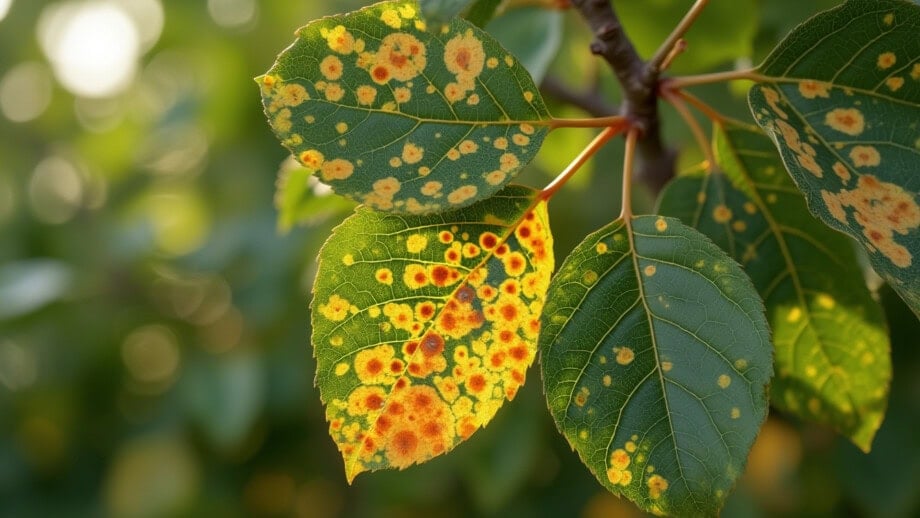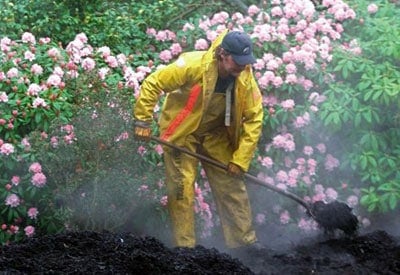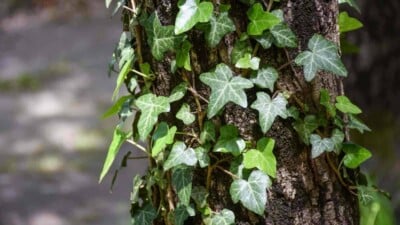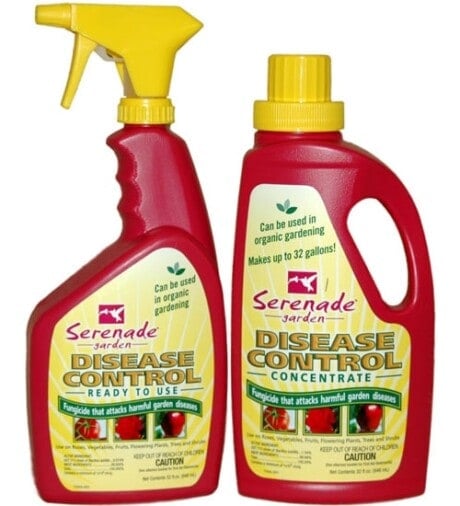Rust Fungus: Identify Symptoms to Treat and Control Rust Disease
Learn how to identify and get rid of rust on plants using proven, organic and natural methods.

There are around 8,000 named species of rust diseases, many of them host-specific. Scientists speculate there are many more types of rust diseases in the tropical and subtropical regions of the world that have not been discovered yet. Rust diseases are an important class of plant pathogens that affects many economically important crops, including cereal crops, flowering plants, and ornamental plants. Biologists think rust fungi are very ancient to have had the opportunity to co-evolve with so many plants.
Because rust fungi are obligate parasites, they will only live on living plants. The fungi creates a structure called a haustorium out of the fungus cell wall and the plant cell wall, which is where the food from the plant goes to the fungi. Even if the fungus is given all the food it needs, it will not grow in a petri dish without the living plant cell of its plant host. This makes it difficult to grow it in the lab, so there are things scientists just don’t know about it yet.
Rust does not usually kill its plant hosts, but can severely limit the growth of plants and their production of food for people. The Irish potato famine was caused by a species of rust that rotted the potatoes in the ground or in storage into a goeye mess. Not only did many Irish starve, but the influx of the Irish into the United States was also caused by that famine. Rust has contributed to other famines through history.
What is Rust Disease?
Rust disease is an obligate fungal parasite that grows on a wide variety of plants useful to humans. All rust fungi are in the order Pucciniales (formerly Uredinales) although there are many types of individual rust diseases. Most of these types can only grow on one or two species of plant.
Symptoms of Rust Fungi
The signature symptom of rust is the orange, yellow, brown, or red spore masses on the outside of the plant. This color gives the rust fungus its name. These spores appear as raised dots on the leaves or stems of the plant. Some types of rust form galls that then become covered in the spore masses. Rust occasionally forms on blooms.
Symptoms occur from the ground up. They are usually on the underside of the leaves but may also appear on the top of them. It may cause witches broom growth (redish, twisted stems and leaves), cankers, oozes, and spotted needles. Rust may cause leaves to fall prematurely. If enough of the leaves fall, the plant may die. Plants may be stunted, off color, and weak. Plants that are heavily affected for 2-3 years in a row may die if not treated. A bad case of rust does not leave enough green areas on the leaf for significant photosynthesis to occur, and the plant starves.
Rust may occur on the bark or needles of conifers. It may cause witches broom growth (redish, twisted stems and leaves), cankers, oozes, and spotted needles.
Some types of turf grass get rust, too. If you walk through the lawn and your shoes have orange dust all over them, you have a rust problem. This is most common in perennial ryegrass, but also effects Kentucky Bluegrass, tall & fine fescues, zoysiagrass, and bermudagrass. You can find rust resistant turfgrass cultivars listed on the National Turfgrass Evaluation Program (NTEP) at www.ntep.com.
Is Rust Fungus Poisonous to Humans?
No, rust fungus is not poisonous to humans or animals. Eating food with rust on it is discouraged because the flavor is often off.
Life Cycle of Rust Fungus
Rust has a complicated life cycle, but it is important to understand so you know how to interrupt the life cycle and take care of infected plants. Some species of rust go through five stages on two different, unrelated plants. Other species go through fewer life stages and may only infect one plant species.
The optimum conditions for a rust infection are when temperatures are between 68-86F and the foliage is wet. The leaf needs to be wet for 6- 10 hours. A rapid increase in temperature and higher light intensity after that is also conducive to infection. This means plants that are wet all through the night, followed by sunrise and warmer temperatures, create ideal conditions for rust infections. We will be using the Puccinia graminis (Wheat stem rust fungus) as an example of rust disease with all five stages and two hosts.
On Barberry
Stage 0
The basidiospores, made when the overwintering teliospores germinate, infect the barberry plant. They create spermogonia. Each spermogonium has receptive hyphae (female) and spermatia (male). The spermatia have to get to the hyphae to “fertilize” it. The spermogonium produces a sweet nectar substance that flies love. The fly crawls from spermogonium to spermogonium to drink the nectar. She tracks spermatia into hyphae, just like bees track pollen. This is the sexual reproduction stage for the fungus. If this does not happen, the cycle stops.
After the sexual reproduction, aeciospores form and must find a wheat plant to continue the cycle. They are often spread on the wind, then get on the wheat plant when water splashes it up on the leaf.
On Wheat
Stage 1
The aeciospore lands on a wheat plant leaf or stem. If the weather is mild and the leaf is wet, the rust spore germinates. It then goes through the leaf stoma, or pore, into the plant. Once in, mycelium (fungal threads, or hyphae) starts growing and begins feeding on the plant. Spraying the wheat plants at green-up is an effective way to kill the rust spores when they begin to germinate but before they enter the leaf pore.
Stage 2
The mycelium gives rise to uredinia bearing urediniospores. As the urediniospores develop, they burst through the plant’s epidermis, or skin, in the classic rusty-colored spores. These urediniospores can infect nearby wheat plants throughout the spring and summer. They can also reinfect their host plant. This is the most dangerous stage of the plant. Once the urediniospores develop, it is too late to control the fungus until the plant goes dormant in the fall.
Stage 3
In late summer, the uredinia convert to telia which bare teliospores. These are the two-celled, thick-walled black spores that will survive the winter. The rusty brown color on the plant begins to change to black as the switch happens. Once the teliospores develop, wait until leaf drop and spray the host plants with a fungicide. This will kill the fungus before it can spread again.
On Barberry
Stage 4
In the spring, the teliospores germinate into basidia, which make basidiospores. These must infect barberry, not wheat. They are usually transported by the wind. If there are no barberry plants, this type of rust cannot continue growing and dies.
Preventing Rust Fungus
It is very difficult to prevent rust fungus in your garden because it appears in such a wide variety of plants. However, there are some cultural things you can do to lower the chance your plant gets rust.
Buy rust-resistant cultivars
Not all plants that get rust have rust-resistant cultivars. When possible, however, you should buy rust-resistant cultivars. Be sure you look for those in seed catalogs. This information is also on the seed packets of resistant varieties. The little tags in potted plants you get from the nursery should have that information on them, too.
Check plants before bringing them home
Only buy plants from a local and reputable nursery. The plants there will be better quality and less apt to be diseased. Before buying a plant at a nursery, check under the leaves of the plant and around the base of it. If you see any spots on the leaves or stem, don’t buy the plant. Find another plant to purchase. You do not want to introduce rust into your landscape if you can help it.
Quarantine New Plants
Even if you do not see any spots on a plant at the nursery, it is a good idea to quarantine new plants for two weeks before placing them in your landscape. There is a point after infection but before the rust spots burst that is not easily detectable. Quarantining the plants gives the rust time to become evident before it spreads to other plants. Most nurseries guarantee their plants, so if they do show the symptoms of rust during quarantine, take the plants back.
How to water plants to prevent rust fungus?
Rust fungus must sit on a wet leaf for 6-10 hours before it can infect a plant. Do not use overhead watering to water a plant. Water using drip irrigation or other methods that do not wet the plant leaves, only the roots. Soil splashing up on leaves during watering is a major method of infection.
Sometimes you can’t help but use a sprinkler system. If you must water overhead, do so from 5-10 A.M. so the leaves dry before nightfall.
Dispose of infected plants and plant parts properly.
Never compost a plant with any disease or pest problem. The problem will be introduced into your compost. When you spread the compost, you spread the disease throughout your landscape.
Put infected plants and leaves into a plastic bag. Seal it well and put it in the trash. That way, the spores cannot spread to other plants.
Fall Clean-Up
Make sure you clean up leaves and other dead plant parts from your landscape beds each fall. If you have rust-affected plants, cut them to the ground at the end of the season and remove them from your landscape beds. Rust overwinters on leaves and removing them can cut the rust cycle off. Be sure and do not compost the leaves if your plants have had rust. Dispose of them in plastic bags and put those in the trash.
Remove Alternate Host Plants
In the example of wheat stem rust discussed above, farmers who removed barberry plants saw a drop in rust on their wheat the year following the barberry cull. If you have a rust problem and the rust uses two hosts, remove the less desirable of the two hosts to control the rust problem. This doesn’t work if the rust species you have only uses one host.
Hot Water
Because rust can only exist in such a narrow temperature band, hot water kills some types of rust. An example is geranium rust (Puccinia Pelargonii-zones). However, the hot water does some damage to the plant, also.
Wash Tools and Shoes
Rust usually disburses in the wind. However, if you have a plant with rust, make sure you wash your tools and shoes before moving on to the next plant. Spores are tiny and can hitch a ride on your shoes and tools to your other plants. Wash tools in a solution on one part bleach and nine parts water. There are disinfectant solutions you can step in to kill pathogens like rust on your shoes.
How do you treat rust fungus?
If these cultural controls do not keep your plants safe from rust disease, there are some things you can do. Inspect your plants frequently, especially at the base of the leaves near the soil. If you find symptoms of rust, you can remove the leaf that it appears on. Don’t remove more than 1/3 of the leaves at one time. Once you find rust in a vulnerable species, you will need to treat it to save that plant and others of the same species in your landscape.
Chemical treatments
Chemical fungicides should be used in early spring right when new growth appears on the plant or in the fall after leaf drop. Fungicides are not effective after rust symptoms appear. Chemical fungicides have to be repeated every 4-5 weeks while the temperature and moisture are conducive to the fungus. After the weather warms up, rust cannot reproduce even if it is present in the plant, so you can stop the treatments.
Before using a fungicide, be sure the label mentions the name of your plant or family of plants on it. Obey all the directions and warnings on the label. Remember, the label is the law. Wear long sleeves, long pants, and closed-toe shoes to use any chemical, including organic ones. Be sure to change clothes after you use the fungicide so you don’t track it into the house.
Fungicides can be expensive, so determine the value of the plants you want to protect. A very low level of rust in a full landscape can probably be controlled by removing infected leaves without having to use fungicides. If the plant is a high value plant, then it may be worth it to administer a fungicide. The same is true if the alternate host to a rust infecting a high value plant cannot be removed.
There are many different synthetic antifungals around. Your Extension agent can recommend some if you want to take that route. If you want to use an organic anti-fungal, you have two choices.
Copper Fungicides
Copper fungicides can provide control of some rust fungus, depending on the species of rust. Rust fungus has evolved to display resistance to some fungicides, so contact your Extension agent to find out if the rust you have is susceptible to copper.
Sulfur Fungicides
Sulfur fungicides provide control of rust fungus. As with copper, some rusts may be resistant to this fungicide. Do not apply sulfur after the temperature has warmed up as it will damage the plant.
So many different plants are susceptible to rust fungus that most gardeners will see at least one case of these fungal plant diseases. There are many things you can do to protect your plants from rust fungal diseases. When you find rust, remove the infected plant parts, if possible, and dispose of them carefully. Treatments for rust must be used at green-up in the spring or at leaf drop in the fall. By the time symptoms appear, it is too late.
Treatment
- Select rust-resistant plant varieties when available.
- Pick off and destroy infected leaves and frequently rake under plants to remove all fallen debris.
- Water in the early morning hours — avoiding overhead sprinklers — to give plants time to dry out during the day. Drip irrigation and soaker hoses can be used to help keep leaves dry.
- Use a slow-release, organic fertilizer on crops and avoid excess nitrogen. Soft, leafy, new growth is most susceptible.
- Apply copper sprays or sulfur powders to prevent infection of susceptible plants. For best results, apply early or at first sign of disease. Spray all plant parts thoroughly and repeat every 7-10 days up to the day of harvest.
- Effectively treat fungal diseases with SERENADE Garden. This broad spectrum bio-fungicide uses a patented strain of Bacillus subtilis and is approved for organic gardening. Best of all, it’s safe to use — you can treat and pick crops the same day!
- Containing sulfur and pyrethrins, Bonide® Orchard Spray is a safe, one-hit concentrate for insect attacks and fungal problems. For best results, apply as a protective spray (2.5 oz/ gallon) early in the season. If disease, insects or wet weather are present, mix 5 oz in one gallon of water. Thoroughly spray all parts of the plant, especially new shoots.
- Prune or stake plants and remove weeds to improve air circulation. Make sure to disinfect your pruning tools (one part bleach to 4 parts water) after each cut.
- Use a thick layer of mulch or organic compost to cover the soil after you have raked and cleaned it well. Mulch will prevent the disease spores from splashing back up onto the leaves.
- Burn or bag infected plants after the growing season (see Fall Garden Cleanup). Do NOT compost.













